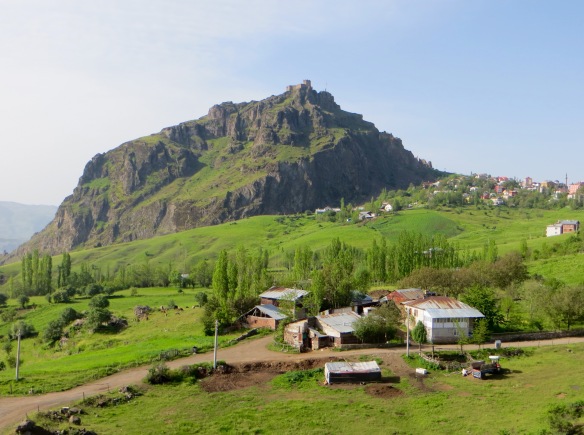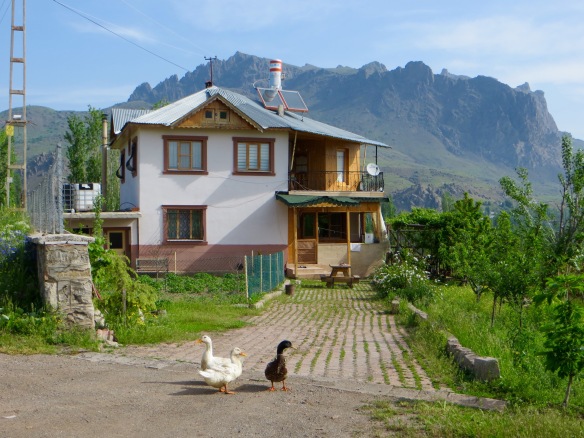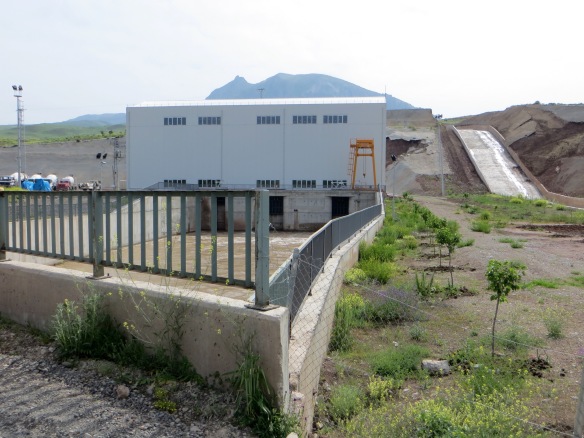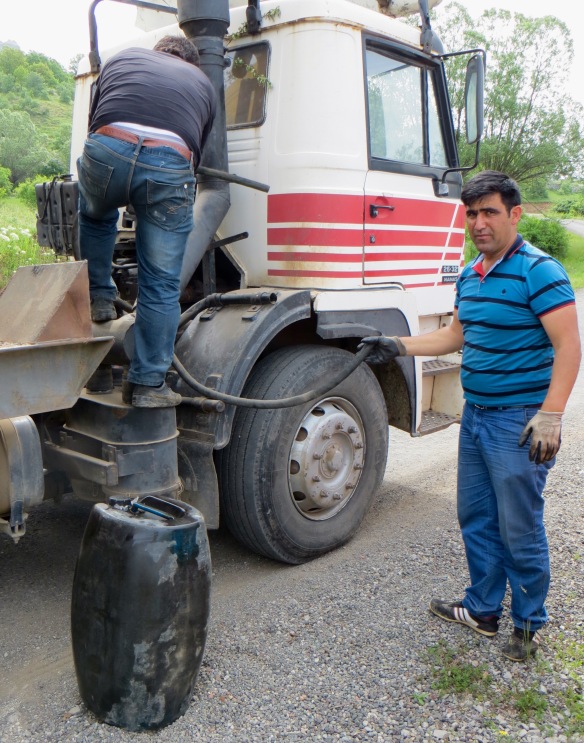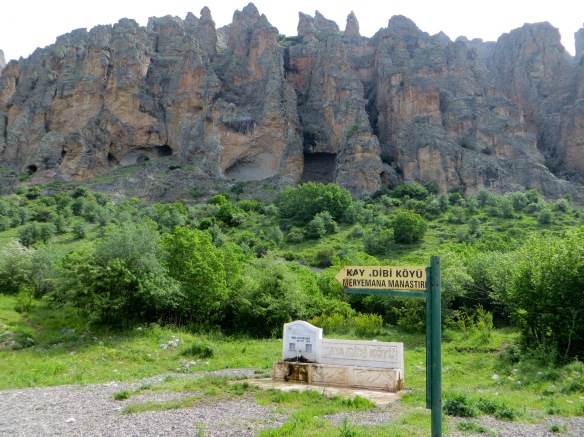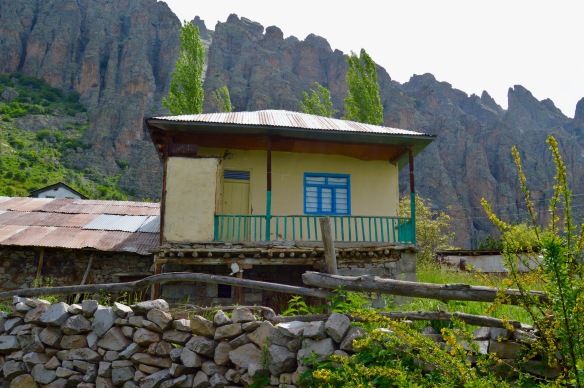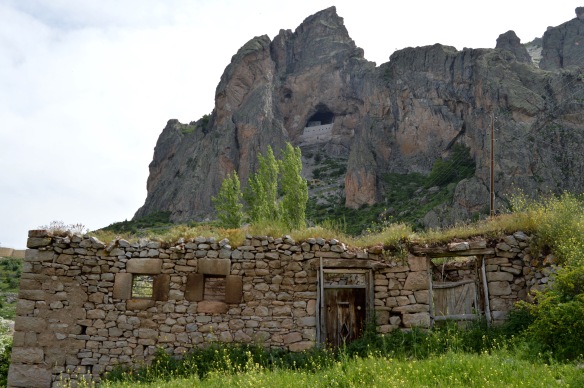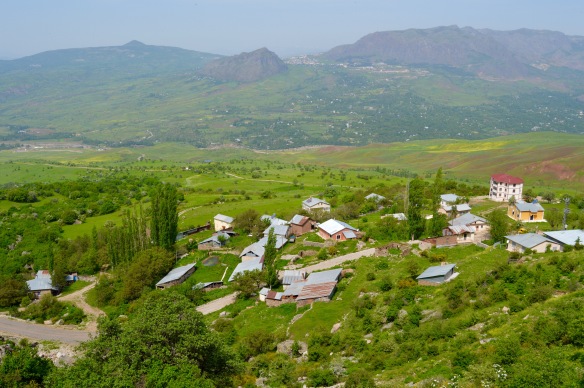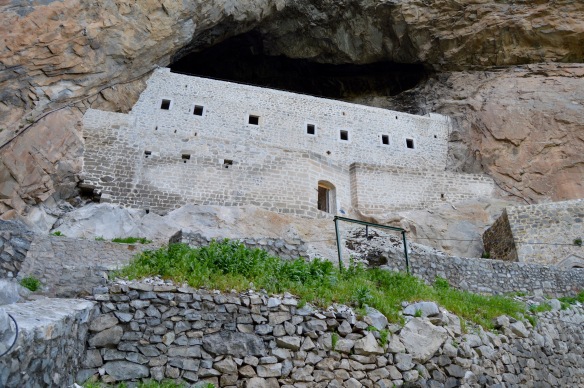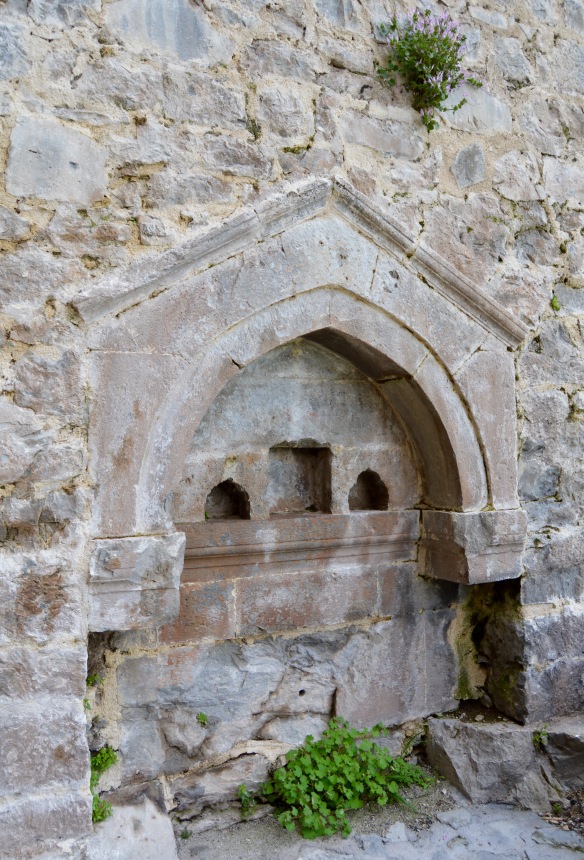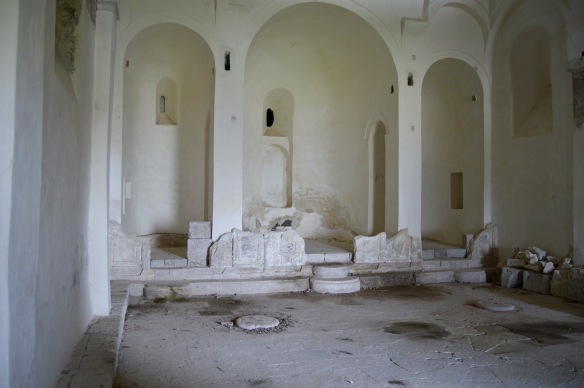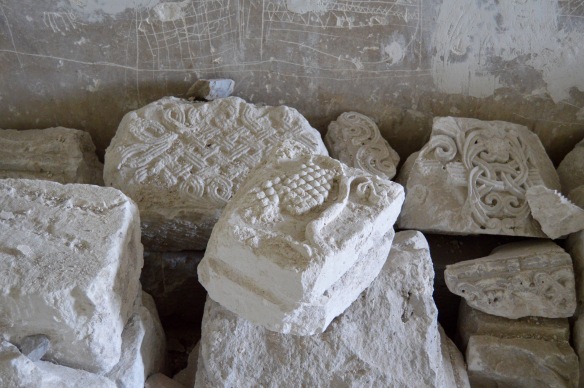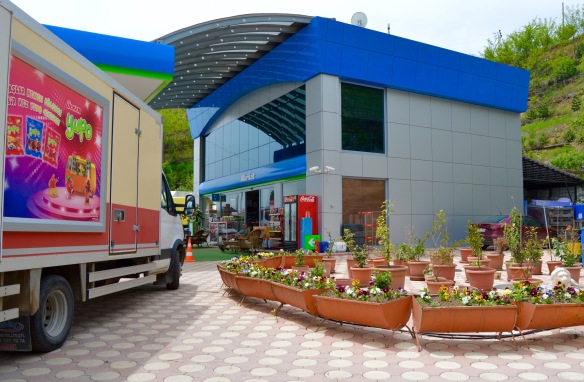Breakfast at the Basaran was served in the café next to the hotel because the hotel and the café were owned by the same people. During the day and early evening, the café was popular with high school and university students of both sexes because in appearance it was clean, modern and female-friendly, but early in the morning, the only customers were guests in the hotel. The breakfast buffet was about as good as the one at the Belediye Hotel in Divrigi, which meant there was nothing out of the ordinary to select from ( on display were bread, butter, jam, honey, pekmek, white cream cheese, black and green olives, boiled eggs and tea). However, given how cheap the hotel was, there was no reason to complain, not least because I had three cups of very good tea.
The main purpose of the day was to visit Kayadibi Manastir about 9 or 10 kilometres south-east of Sebinkarahisar as the crow flew, although I knew the road to the monastery meandered all over the place to account for the lie of the land and the distribution of villages along the route. Although Sebinkarahisar used to have a large Armenian population, the area around the town had always had more Greeks than Armenians, so today I would connect, albeit only because of a monument, with another Christian minority that suffered badly, in this case right at the end of the Ottoman era.
Once the war between the Ottoman Empire and Greece had ended in 1922, a war responsible for the death of thousands on both sides, an exchange of populations followed with a large number of Turks in Greece leaving for what would soon be Turkey and a larger number of Greeks leaving what would soon be Turkey for Greece. While today roughly 100,000 ethnic Turks lived in Greece, the number of ethnic Greeks living in Turkey was no more than 4,000. Why was the total number of Greeks in Turkey so much lower than the number of Turks in Greece? Because Greeks in Turkey have always suffered much more discrimination by the state and hostility from the general population than Turks in Greece. Moreover, the Greeks of Istanbul suffered a pogrom in September 1955. The death and destruction accelerated migration from Turkey, as was no doubt the intention of the Turkish government that had organised it. It is worth pointing out that no pogrom has ever been directed against the Turkish minority in Greece since the Turkish Republic was created in 1923.
Despite what I have just said about Greeks once outnumbering Armenians in the area, in 1915, Sebinkarahisar was one of the few places where Armenians resisted the genocide. As news of deportations and massacres in other parts of the Ottoman Empire reached the town, its Armenian population made preparations for self-defence. On 15th June 1915, about 300 Armenians, most of whom were wealthy merchants, were arrested. On the following day, after further attempted arrests, fighting erupted and barricades were erected in the town’s Armenian districts. By 18th June, most of the Armenian districts had fallen to Ottoman forces or been abandoned. Some 5,000 Armenians from the town and nearby villages, 75% of them women and children, retreated into Sebinkarahisar’s citadel. The citadel was surrounded by Ottoman troops who directed heavy artillery at its walls. On the night of 11th July, with food, water and ammunition almost exhausted, the Armenians decided to secretly evacuate their sanctuary. However, the attempt to evacuate was discovered and all the people involved were killed. On 12th July, the Armenians still inside the citadel surrendered. A massacre followed in which all Armenian men were killed. Surviving women and children were held prisoner before being deported like women and children in other towns. According to official Turkish records, Armenian rebels killed just over 400 Turkish villagers during the revolt.
I had done some research about Kayadibi Manastir and knew it had recently benefitted from a substantial restoration programme, so much so that photos on the internet reveal that it looked in far too pristine a condition. On the other hand, at least the restoration had taken place, thereby giving the monastery a new lease of life. Its location in a large cave more than half way up a mountain was very unusual (aspects of Kayadibi Manastir were reminiscent of the far more famous and regularly visited Greek monastery at Sumela south of Trabzon). Also, I knew that getting to it would be half the fun and some of the villages along the road would probably be of interest. I was confident that a delightful morning lay ahead.
I had already been advised that, although the monastery lay to the south-east of Sebinkarahisar, the road to it split from the road leading eventually to Giresun, so I walked through the town centre in a northerly direction, confirmed where I was going with two men working at an oto lastik and, after about 1.5 kilometres, came to a junction to the right with a sign indicating that the monastery lay along it. This in itself was interesting. All the Armenian monuments so far visited lacked signs indicating where they were or that they even existed, Surp Giragos Church in Diyarbakir excepted, but the first Greek monument I wanted to track down had a sign to it. Sadly, the sign did not reveal how far away it was.
The walk from Sebinkarahisar in bright early morning sunshine had already provided sublime views of the citadel perched on its mountain, and all the way to the monastery, views of equal splendour and delight were routine. But getting to the monastery was not as straightforward as the sign at the road junction had promised because no more signs followed until I was within sight of my destination. This was so despite the intricate network of roads meandering through the undulating countryside. The roads linked small villages dependent on the fields, pasture, orchards and woodland that made the area so green and welcoming. It took two short lifts, three walks totalling about 5 kilometres and two wrong turns until I got through the last village, crossed a river and entered open countryside dominated by pasture, but the monastery in its large cave was at last clearly visible. Also, I was now walking along the only road that I could follow and it was ascending gently toward its destination.
Before getting this far, a young couple from Istanbul drove me 2 or 3 kilometres. They were visiting relatives who lived in a house in one of the villages closest to Sebinkarahisar, a village of about 20 houses surrounded by gardens and orchards. I then walked to a village large enough to support a small mosque, an elementary school and a tea house. At the latter, the day’s first customers, all of whom were inevitably male, invited me to rest a while, but I politely declined the offer. About 400 metres outside the village, I heard a minibus approach and flagged it down. I was given a lift of about 1.5 kilometres to a junction and told to go to the right before the minibus turned to the left. This looked incorrect because I would be taken away from the monastery, but I was wrong to doubt the advice given. The roads went every which way because of the lie of the land. As for the minibus, it was picking up pupils and students and taking them to Sebinkarahisar for lessons, but two women had flagged a lift to get to the fields where they would work for most of the day.
A little later, I took a wrong turn and arrived in a village in a more exposed position than the ones I had been to already (the villages so far had been among lots of trees providing shade that must have been very welcome during the hottest part of the year). I met a man walking cattle from one pasture to another. He confirmed that I had taken a left when I should have taken a right, but the good news was that a track, once the main road itself, left from the centre of the village and provided a short cut to where I needed to be. I walked into the centre of the village where there were neither shops nor a tea house and found the track. The track meandered through the fields and pasture, both of which had many wild flowers including irises and daisies with large heads. About ten minutes later, I was back on the correct road. This led to the river mentioned earlier and a small reservoir. Just beyond the concrete channel that allowed water to flow from the reservoir into the river below, I met three men beside a car with an open bonnet. The men were fixing a fault with the electrics. Not long after we had met, they were away again. They waved enthusiastically as they passed me ascending the road.
By now, I had seen rape growing wild, tall blood-red poppies with large petals and, beside the road and among the trees, lots of flowers like dog rose that varied in colour from white to dark pink.
I could now see with greater clarity than ever that Sebinkarahisar’s citadel stood on a mountain at the western extremity of a bowl dominated at its eastern extremity by the mountain with the monastery in the large cave. From my increasingly elevated position, it was possible to see the villages, often with houses dispersed rather than clustered together, that relied on the fertility of the bowl itself. It was still May and everything looked very green.
I walked on, then heard behind me the groan of a very heavy motor vehicle making its way up the road. On the trailer of the vehicle was an enormous earthmover bound for a location a few kilometres away to improve communications by road. I stood to one side to let the vehicle and its load get past me, then it drew to a halt about 50 metres ahead. The driver urged me to get in the cab: he would drive me to within a kilometre or so of the monastery. The monastery was still about 4 or 5 kilometres away so I welcomed the kind offer, although I knew we would not get to a speed much about 10 kph. But it was fun sitting high above the road with wonderful views everywhere I looked and I was saving energy for later in the day.
Ahead of the lorry and its trailer was a car which drove the same pace as us. I realised immediately that the car had something to do with the motor vehicle in which I sat, but, in my naivety, thought it might be preceding us to clear a path along the road should there be a build-up of traffic (on our quiet road, a build-up of traffic was most unlikely, but the vehicle had started its journey the day before at Giresun on the Black Sea coast). Not far short of where I was dropped off, the purpose of the car became apparent. The motor vehicle in which I sat drew to a halt and the car backed up as close as it could get to the cab. The boot of the car was opened to reveal a very large plastic container full of petrol. The car carried the fuel that the motor vehicle required when it was some distance from a petrol station. The plastic container was lifted onto a resting place above the petrol tank and the caps on the container and tank were removed. A long hose was inserted into the plastic container and the man driving the car sucked on the other end to draw down some petrol, which flowed immediately into the tank once the end had been put into the fuel filler neck. Five minutes later, we were off again.
I was dropped at a cesme at the south end of the village. I filled my water bottle before walking past a flock of sheep and goats looked after by a man aged about 40. The village of Kayadibi spread across undulating ground immediately below the mountain with the monastery in the cave and, because it faced west, it overlooked the fertile bowl through which I had just navigated with indifferent luck in relation to the most direct route. Higher than any other village so far visited since breakfast, trees did not obscure the views. Housing was a mixture of old and new. Generous amounts of corrugated iron were used to cover roofs and protect damaged walls. Lots of grass and wild flowers added to the visual interest. I saw only three people the whole time I was at the village and no one was at the monastery until I was just about to leave. As I began to descend the meandering path, a middle-aged man arrived with a woman aged about 20.
From the village and the path leading to it, the monastery was in view almost all the time because part of it was built in the mouth of the cave rather than just at the back. The monastic complex spread over four levels with the church at the highest point. The levels below the church had many rooms. Some of the rooms appeared to be in their original or near original condition, but others looked like reconstructions. The stone walls were sometimes covered with plaster, but most were left bare.
Some sources (Sinclair is silent about the monument) insist that the monastery dates from as early as about 490 CE, which is quite possible given how far Christianity had spread from its Palestinian homeland by that date, and given that Christianity was the official religion of the Byzantine Empire that ruled these parts during the 5th century. The monastery began life much smaller than the complex that existed today and some sources say that it benefitted from a major renovation programme in the 19th century, a renovation programme that resulted in a much larger monastery than had been in the cave before. Some sources refer to the monastery being “burned” or “destroyed” prior to the renovation programme.
Just below the monastery to the right-hand side as I looked into the cave was a very pretty cesme enclosed within a pointed arch, and near the cesme were steps cut into the rock that led to the monastery’s small entrance. From the entrance, I could access the ground floor of the complex from where I made my way level by level through what used to be rooms for pilgrims and guests, a kitchen, a refectory and monks’ cells. I eventually reached the church with its triple apse.
I thought I would be depressed because this delightful complex in the mouth of a cave high above the village of Kayadibi (or the village of Sariyer. Many villages in Turkey had more than one name) had been restored to such a perfect but severe degree that it looked like a built-from-scratch edifice. But what most depressed me (and inspired suppressed rage) was that people had engaged in vandalism and added graffiti to the walls despite the restoration being completed only two or three years earlier. Vandalism and graffiti even disfigured some parts of the monastery that were original. Perhaps the worst thing of all was when I examined vandalised stone in the church that had been intricately carved a long time ago, at least as early as the 19th century and in all likelihood much earlier.
The graffiti confirmed that the people responsible for the vandalism were Turks and/or Kurds. I would have thought that Turks and Kurds would have abstained from damaging the monastery as a mark of respect for the Turkish and Kurdish craftspeople who had restored it with often enviable skill, but their contempt for Christianity and/or the Greeks would seem to be so great that they could not resist giving it expression. I dislike saying it again, but was I confronted with more evidence that Muslim contempt for things non-Muslim was sometimes so great that it outweighed the duty we all have to care for the cultural artefacts left by the long-dead people who precede us, no matter their background.
If Muslim contempt for non-Muslim cultural artefacts in Turkey can be so great that Turks and Kurds vandalise non-Muslim monuments restored over a substantial period of time and at great cost to their national or provincial governments, perhaps it is easier to understand why supporters of the Taliban and the Islamic State have such contempt for the cultural artefacts of people they despise, even people they despise who have long been dead and whose cultural artefacts are at world heritage sites. Back home, I read about Muslims in Egypt who had damaged the Sphinx and campaigned for destruction of the pyramids. However, I have yet to hear of a non-Muslim who wants to destroy the Taj Mahal in Agra or Ulu Camii and the Hospital in Divrigi, although, if Muslims continue to destroy non-Muslim cultural artefacts of global importance at world heritage sites and elsewhere, an Islamophobe is bound to eventually argue for the destruction of cultural artefacts important to Muslims. Sadly, Muslims are already destroying important Muslim cultural artefacts. Think of how Sunni Muslims destroyed delightful Sufi monuments some years ago in Timbuktu in Mali and Shia pilgrimage sites more recently in Iraq. If the war ever ends in Syria (the war will eventually end, but there is no evidence yet that many Syrians will come to their senses soon so that it does end), we will find that Sunni Muslims have targeted hundreds of monuments important to Alawites and Alawites have targeted hundreds of monuments important to Sunni Muslims.
At present, Islam is the belief system that inspires the greatest number of its followers to engage in burn, burn rather than build, build. Is this destructive inclination (just think of the costs in terms of human lives, the environment and things made by humankind) reflective of how the religion has always been, or are Muslims going through an abnormal period that will end as suddenly as some believe it began? Or are Muslims trying to bring forward the end-time that all three of the Abrahamic faiths suggest is a God-given inevitability? I am compelled to say, “Please protect us from people who think they know the truth because they have an insatiable appetite for death and destruction.” Nowadays, I instinctively back away from such peddlers of truth. Give me a man or a woman of science in preference to a man or a woman of religion (although if there were more women than men in positions of authority in religion, religion would not be the often dire phenomenon it so often currently is, but this is another matter altogether).
Although the vandalism and graffiti at the monastery filled me with considerable disquiet, I was impressed with some of the restoration work that had obviously been costly and time-consuming. But, as I walked down the path to the village, some light fittings on a wall had fallen over or broken (had they been badly made, poorly installed or vandalised?) and grass and other plants grew in cracks in the cement between the stones laid to make it easier to access to the monastery. The grass and other plants were contributing to some of the cement coming away.
I took a few last photos in the village, then flagged a car for a lift toward Sebinkarahisar. I was in luck: the driver was going all the way to the town centre. The road meandered mostly the way I had come and confirmed what I already knew: no matter how you got from Sebinkarahisar to Kayadibi Manastir and vice-versa, the walk or drive was a very pretty one.
Because I was in Sebinkarahisar by midday, I had the time to travel part of the way to Giresun, which was said to be a scenically rewarding road. I looked at my map of eastern Turkey and decided that Tamdere, just over a third of the way to Giresun, would be the ideal destination, not least because I would have crossed the highest pass on the road, one at 2,200 metres above sea level. I hoped that Tamdere would be high enough in the mountains to have paths or dirt roads leading higher up and was confident there would be some snow.
I walked to the otogar where I found that minibuses did the run roughly every hour from Sebinkarahisar to Giresun with the last service both ways not departing until about 7.00pm. This meant I could rely on public transport until nightfall if hitching let me down. Because the next minibus did not depart until 1.30pm, I rushed back to the hotel to quickly freshen up, called at a small supermarket for a litre of orange juice (orange juice, ayran and water were what I craved the most for refreshment, unless it was the occasional ice cream) and returned to the otogar with half an hour to spare. I sat down inside with something to read, but the man responsible for a shop selling local sweets urged me to examine what he stocked. I was given an excellent piece of pestil, which confirmed what I had found the night before. People in Sebinkarahisar took their food seriously and a lot of their food was seriously good.


